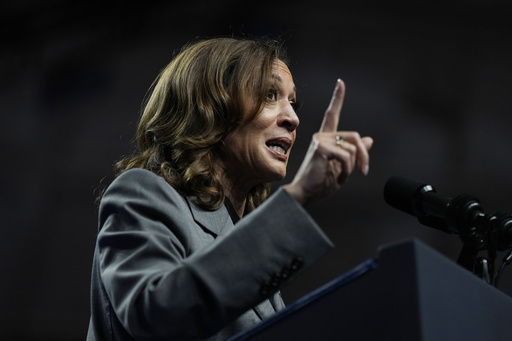OMAHA, Nebraska (AP) — Terri Sanders stood among the dozens of voters who turned out Tuesday afternoon to pick up campaign signs at a Democratic event in north Omaha.
“I haven’t seen outreach like this in a long time,” the 67-year-old CEO of an African-American newspaper said of Democratic presidential nominee Kamala Harris ‘ organizing campaign in Nebraska’s 2nd Congressional District, which includes Omaha. “Not since Obama.”
The honking car horns and pulsing music were a small measure of the energy Harris and Democrats are putting toward winning a single Electoral College vote, thanks to a quirky formula that allocates Nebraska’s five electoral votes based on the votes in individual congressional districts in an otherwise reliably Republican state.
In a national race that by all current measures seems exceedingly close, one small electoral vote could provide the margin of victory. So Democrats have planted a large flag.
Harris and Democratic groups have spent more than $5 million in the district since she entered the race on July 23, and have more than $6 million in ad time reserved through Election Day, Nov. 5, according to the media-tracking firm AdImpact. Former President Donald Trump’s campaign, on the other hand, had spent only about $95,000 on advertising in the state and had reserved roughly $6,800 through Nov. 5.
Trump and Republican allies had sought another route to victory, namely to persuade the Republican-dominated Legislature to rewrite the state’s rules and make Nebraska a winner-take-all contest instead of awarding its Electoral College votes by congressional district. Maine is the only other state that awards its votes that way. (Trump won the Nebraska district in 2016, but Joe Biden won it in 2020.)
A Republican state senator in Nebraska took that option off the table on Monday when he refused to bow to pressure from Trump and other Republicans to change the rules so close to the election.
Lacking the votes in Nebraska’s unicameral Legislature, Republican Gov. Jim Pillen said Tuesday he would not call a special session to attempt the change.
In addition to the television advertising, Harris’ team has 25 paid staffers and three offices dedicated to organizing a district with a population roughly the size of Las Vegas and covering geography larger than Rhode Island but smaller than Delaware.
It’s that kind of organizing that suggests Harris is committing her fundraising advantage not just to ads, but to neighborhood-level outreach in the district, as well as seven targeted states, said David Axelrod, a former senior adviser to President Barack Obama.
“The fact that they have the resources to compete in that district tells you something about A, their focus, and B, their capacities. In a close race, that can really matter,” said Axelrod. “We’re looking at marginal races across the seven states and, in some of them, that may be decisive.”
The district is a distinctly Midwestern micro-battleground, with its Democrat-heavy urban core where the Union Pacific Railroad was born. To the south are politically mixed inner-ring suburbs of working-class neighborhoods and several meatpacking plants, with more politically mixed suburbs to the west.
For Nebraska’s 2nd District to break the tie in the race for the winning majority of 270 Electoral College votes, Trump would have to win all Republican-leaning states plus Arizona, Georgia, Nevada and North Carolina. He would also have to win Maine’s 2nd Congressional District, which he won in 2020, while losing the state overall.
Harris would have to win all Democratic-leaning states, including Maine, plus three northern battlegrounds, Pennsylvania, Michigan and Wisconsin, for Nebraska’s 2nd to make the difference.
It’s far from clear what Trump has working for him in Nebraska’s 2nd District, outside of the small sum spent on TV and the unsuccessful effort to lobby chief Republican Sen. Mike McDonnell of Omaha to side with majority Republicans in backing winner-take-all.
The Trump campaign has a Nebraska campaign director and an election integrity director, staff, volunteers and offices, campaign aides said. However, they declined to say how many were working specifically in the 2nd District.
Campaign aides would only say voters in Nebraska generally had heard from Trump volunteers by phone, in door-to-door outreach and at public events, and that volunteers from around the state had called into the 2nd District to help.
Candidate activity has been light.
Republican Vice Presidential nominee JD Vance headlined a Trump fundraiser in Omaha on Aug. 21, about four days after Democratic vice presidential nominee Tim Walz headlined a Harris campaign rally in the city. Second gentleman Doug Emhoff visited Omaha in July for a small-business campaign event.
The Harris campaign, advised by veteran Obama organizer Mitch Stewart, has conspicuously placed one of its three district offices prominently on Omaha’s 24th street, the main north-south route into north Omaha, the heart of the city’s Black voting bloc.
It was near that office that Sanders was collecting her sign at the Democratic get-together Tuesday, where volunteers were painting blue circles on white signs, simple symbols spotted throughout Omaha, representing Democratic-voting households in a state surrounded by Republican red.
Sanders, CEO of the Omaha Star — Nebraska’s oldest African-American newspaper — paused before heading to her car and said, “Kamala isn’t acting like she’s got this in the bag, by the way.”
“She’s playing to win in a real way,” she said nodding. “In a real way.”
This website uses cookies so that we can provide you with the best user experience possible. Cookie information is stored in your browser and performs functions such as recognising you when you return to our website and helping our team to understand which sections of the website you find most interesting and useful.
